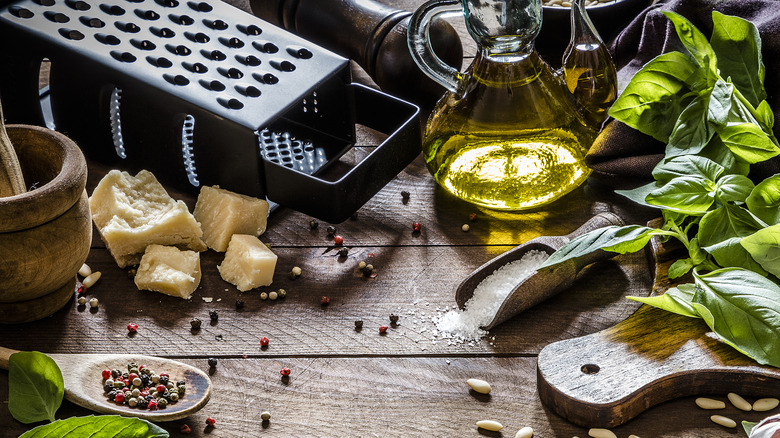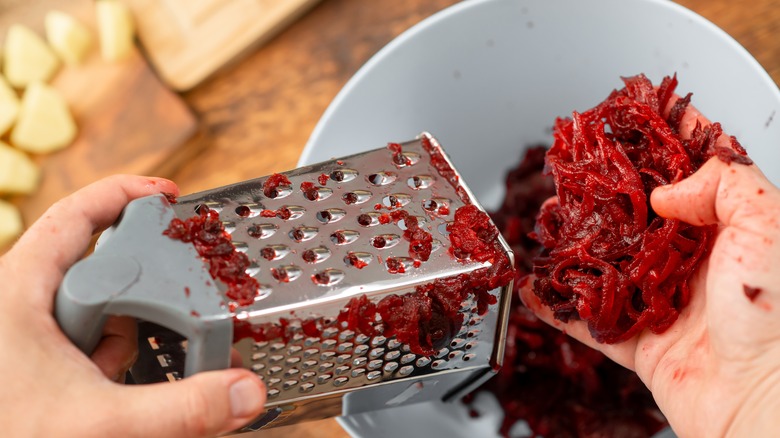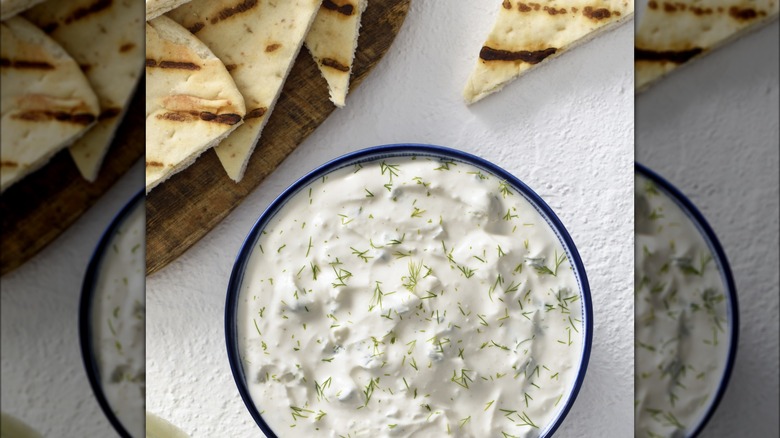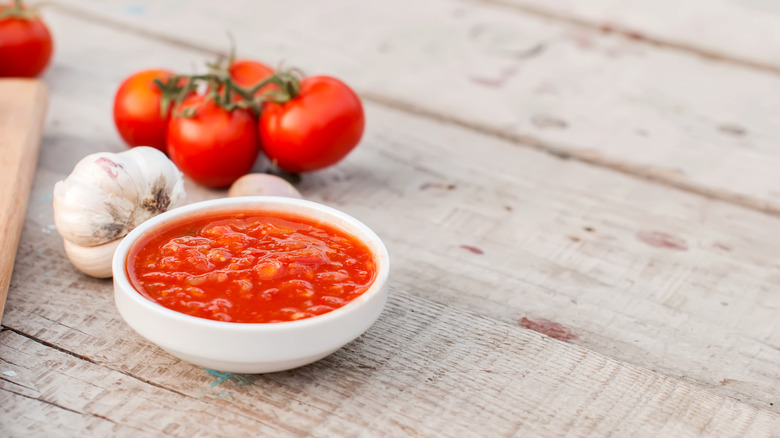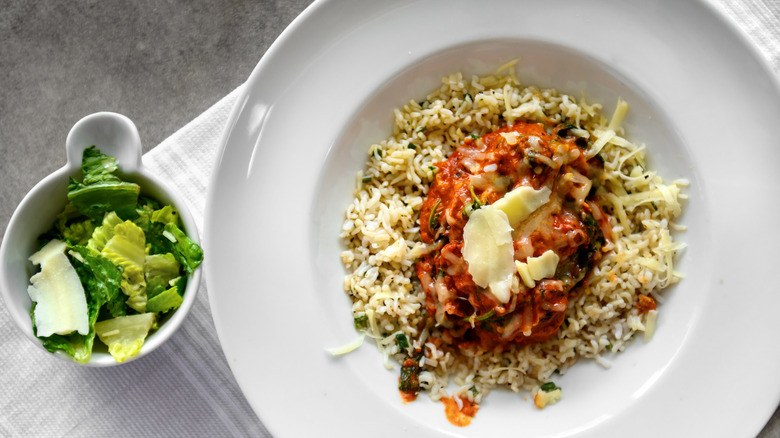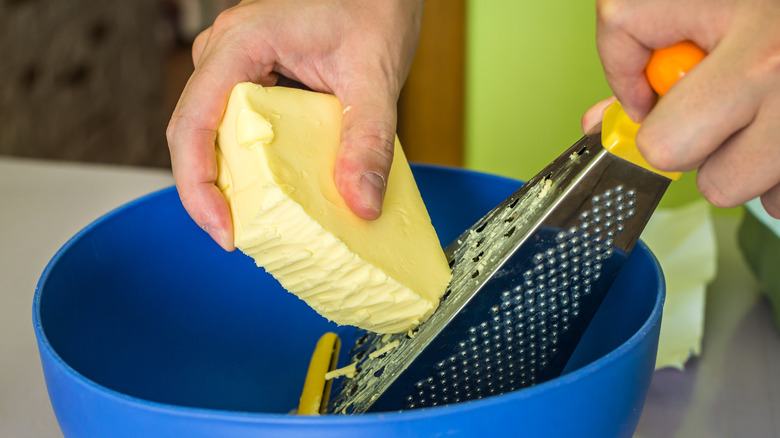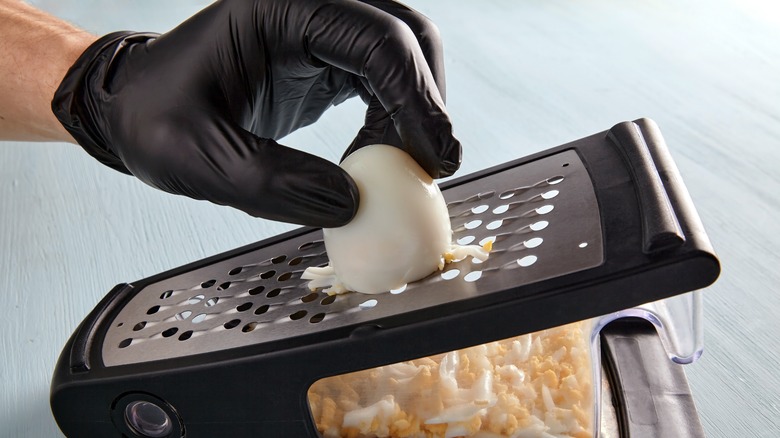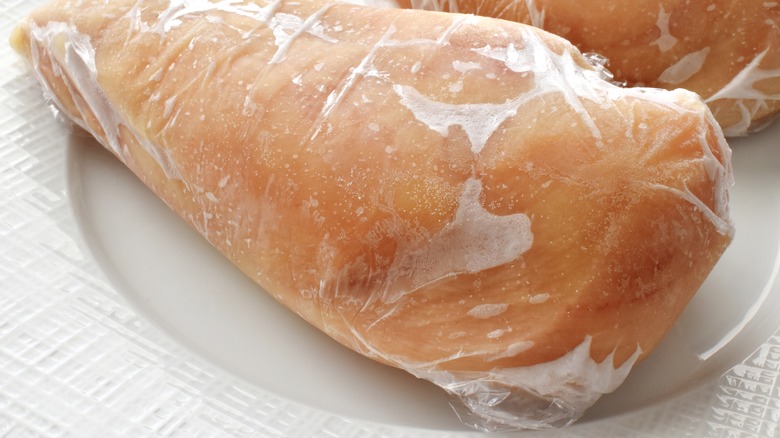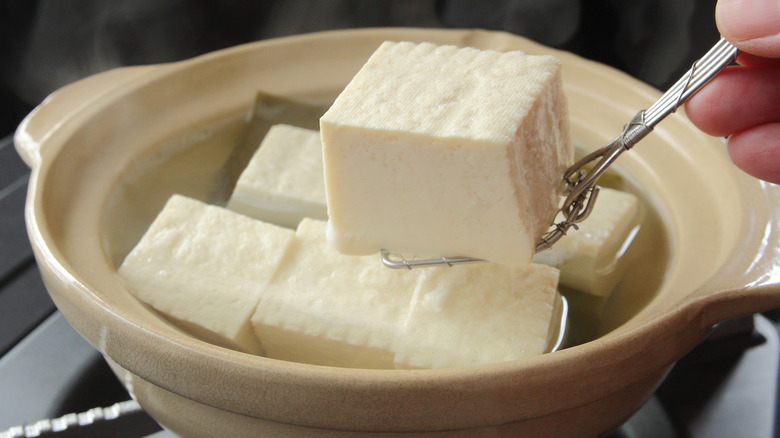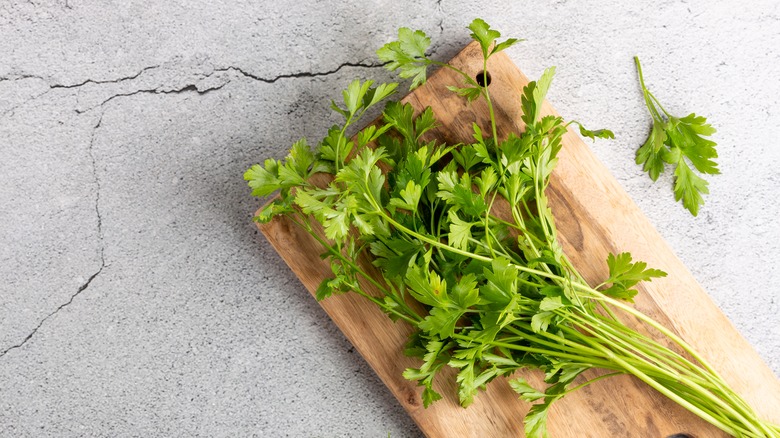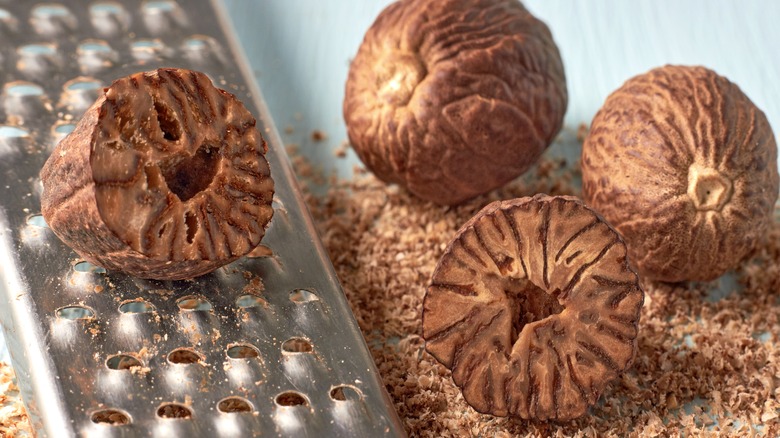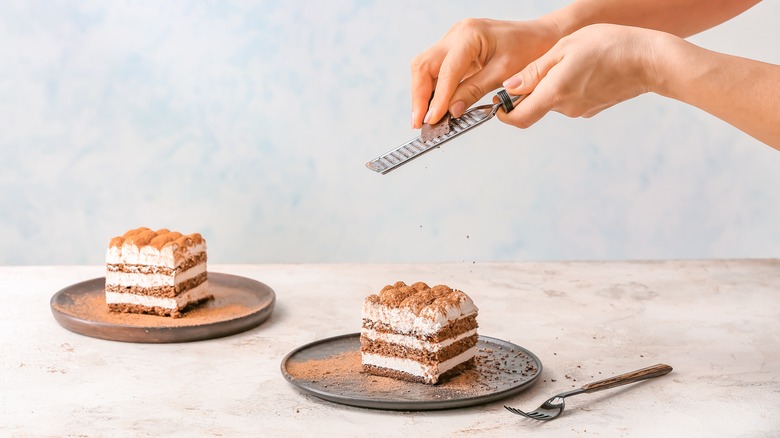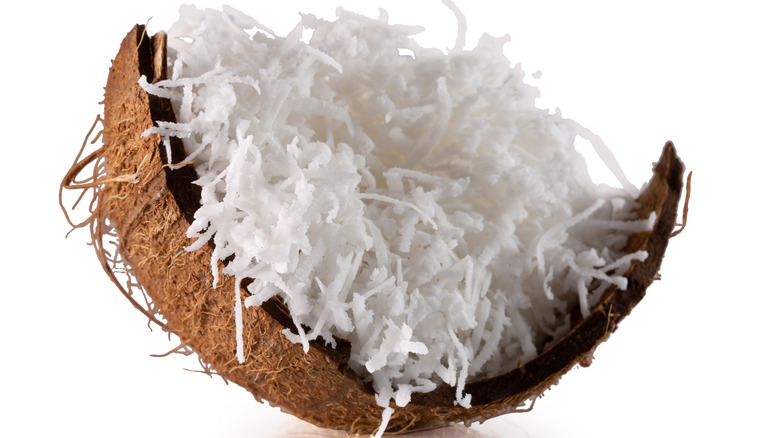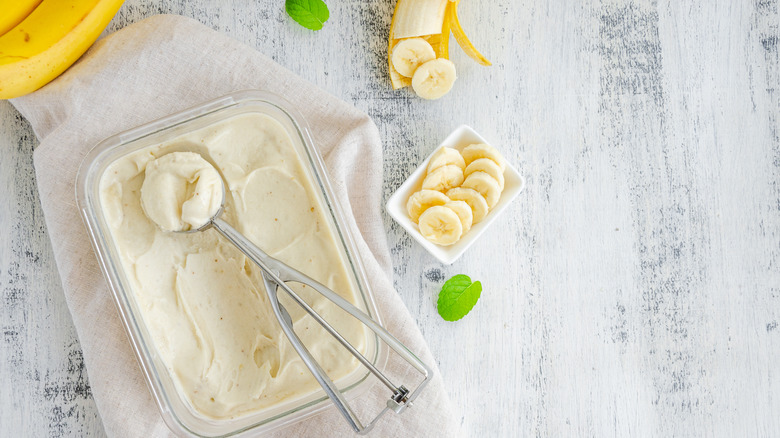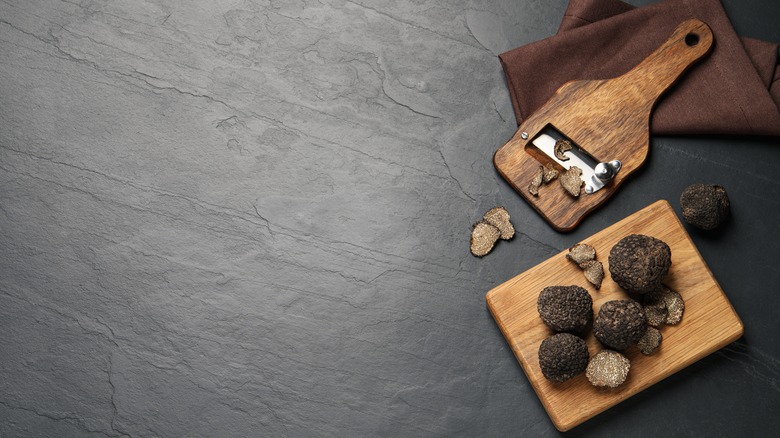15 Creative Ways To Use Your Cheese Grater
You might already use your cheese grater to shred hard cheeses, citrus zest, garlic, or onion, but that humble tool sitting in your kitchen is capable of more. The grater is a versatile piece of equipment that can turn anything from grating root vegetables to mincing tomatoes to shredding dough for homemade pasta into an easy job. You can even grate soap with it, to make a homemade detergent.
The grater has a long history — it was mentioned in Homer's The Iliad and was depicted in some Etruscan tombs of Cerveteri. Most graters are made from metal, with parts like handles and edges covered with rubber or fully made from plastic. Besides metal, there are graters made from wood or ceramics, although these are rare.
And, of course, there's a variety of types there: a box grater, a hand grater, a Microplane (which is actually a rasp grater), a mandoline, a spice grater, or a rotary grater. And of course, aside from these multipurpose ones, these are specialized types — like zesters (meant exclusively for citrus fruits) or nutmeg graters that do their job very well but not be useful for anything else.
With that in mind, we've put together 15 creative ways to use your cheese grater, and you can use a box grater for all of them. From breakfast to desserts, this lineup of options will change the way you cook.
Grate root vegetables and potatoes
Beetroots, carrots, radishes and horseradishes, potatoes, and other root vegetables are part of many dishes. A grater is an easy way to mince them, whether you grate to make them look aesthetically beautiful or you want to hide their presence (for example, when you want to sneak some carrots into muffins or veggie cakes).
That's not all — a grater is your best friend when you need fresh ginger or turmeric. Ginger and turmeric roots have a myriad of health benefits, and they make for great spices. A fine grater like a Microplane or the teethlike, raspy holes of a box grater does a great job at grating them. Simply peel the skin from a fresh root, cut it into convenient pieces, and grate them into a pulp.
Depending on the dish, you could use all four sides with the same vegetable. For example, you use large coarse holes to make shredded carrot salad, smaller shredding holes when making a carrot cake, and a slicing side to make vegan lox.
Mince peeled cucumbers for a classical Greek dip
Peel the cucumbers and grate them on the coarse side of a box grater to easily mince these veggies for some homemade Tzatziki. Tzatziki is a classic Greek dip that uses Greek yogurt, olive oil, fresh herbs, and cucumbers. It is one of the most-known Greek recipes, and you can often find it in restaurants across America and the world. It is also very healthy and simple to make.
Peel the cucumbers, then grate them on your cheese grater (large coarse, or small shredding holes — both would do). Chop up the dill and garlic, and add them, together with cucumbers, to the Greek yogurt. Add a little salt and olive oil, and mix.
Tzatziki goes great with veggies or crackers and is delicious with pita chips. It goes well with many Greek and non-Greek foods, so you should try serving it with grilled chicken, lamb, or beef. Putting it as a spread on a sandwich is another mouthwatering option, too.
Mince tomatoes for tomato sauce, salsa, or salad dressing
A grater is a convenient way to mince a small quantity of tomatoes into a pulp. It means you need to wash only one additional kitchen tool and skip a blender or a food processor.
Get good quality, firm tomatoes. Put the box grater in a bowl, cut off the thin slice of the fruit from the bottom, and start grating it from there while holding the tomato by the stem or by the skin. The skin will naturally act as protection for your fingers, while the bowl will catch all the juices and pulp that escape from the fruit. Another big plus of mincing tomatoes with a grater is that you can automatically separate the skin.
Grated tomatoes give a nice texture, whether it's a sauce, a salsa, a salad dressing, or a dip. There are other dishes using tomato pulp too, such as Spanish tomato toast pan con tomate.
Shred cauliflower to make cauliflower rice
Cauliflower is a wonderful vegetable that you can make many fun dishes with. There is roasted cauliflower with tacos, cauliflower "mac" and cheese, or an easy cauliflower adobo recipe, to name a few. You can even make cauliflower rice — a low-carb, Keto-friendly, and gluten-free alternative to traditional rice recipes. A box grater is one of the easiest ways to make cauliflower rice if you need a small batch. It gives shredded pieces a pleasant texture, and there is no chance of turning everything into mush (which might happen if you use a food processor).
Cut off the leaves, slice away any stains on the head, then separate the head into florets. Grate them on a coarse grater to get small, fine pieces. To cook it, heat olive oil, butter, or some other fat in a pan, put in the rice and sauté it for about 5 minutes. Stir often. You can also store raw shredded rice in the freezer for later.
Grate frozen butter for extra flaky pastry
What's important for a pie crust or a biscuit is how flaky it is. One way to achieve such a flaky crust is by mixing tiny pieces of cold butter into dry dough ingredients. This leads us to the grater — an easy way to make those small pieces of butter.
Put a piece of unsalted butter into a freezer for at least half an hour. Lay down some parchment paper on your working surface, take the butter out, and start grating it in the large coarse holes of the grater.
You have to work quickly because the heat of your hand can melt the butter and create a mess. The grated butter pieces can stick to many cooking surfaces, but the silicon layer of parchment paper is not one of them, so it will keep your table clean and butter flakes easy to work with. Once you are done, the shards will easily slide off of it and into wherever you need them.
Grate hard-boiled eggs for egg or potato salad
An egg salad with fine pieces of eggs and many classic recipes of potato salad have one thing in common: They both call for tiny, finely minced pieces of eggs. Consider grating your hard-boiled eggs with a cheese grater — this will give you thin, uniform pieces that are hard to get with anything else.
Boil the eggs and let them cool off before peeling the shells. Grate cooled peeled eggs like you would a cheese or carrot on the large or small shredding holes. The large holes will give egg shavings that you can still distinguish in the ready salad, while small ones will keep the texture but blend in more with the rest of the ingredients. Of course, you'll need to be careful when mixing the salad otherwise the eggs will fall apart.
Egg and potato salads aren't the only dishes that can benefit from grated eggs, either. You could sprinkle some on top of the bread to make an egg avocado toast or try making an extra creamy Polish egg salad.
Grate frozen chicken for chicken and potatoes appetizer
There are plenty of dishes that call for ground meat. Well, there is a way to make such meat without a machine. All you need is a grater and a meat that is frozen solid. Chef Mehmet Akif Çınar offers a quick, simple, and straightforward dish using grated frozen chicken breast, potatoes, and cheese. You'll need these ingredients plus an egg, a bit of oil, some flour, and spices. Grate frozen chicken fillet, raw potatoes, and cheese, and put them into a bowl. Add raw egg, oil, flour, spices, and mix. Put the mixture into a pan, close the lid, and cook it on the stove on the lowest heat.
Use large coarse holes when grating chicken, since smaller ones might just turn it into a mush. Make sure the meat is thoroughly frozen, and work quickly. It might be a good idea to wear two layers of gloves — otherwise, the freezing coldness of the meat is going to make it a painful experience.
Grate tofu for added texture or a as vegan substitute
Tofu is a high-protein, low-calorie vegan and vegetarian product that contains all the essential amino acids a human body needs. It is a nutrient-rich food, and there are many types of tofu with almost unlimited ways to incorporate it into your diet.
Tofu is relatively neutral in taste, and it absorbs the flavors of seasonings and sauces you cook it with. That's especially true for shredded tofu: You could swap it for pulled pork or ground beef, make shredded tofu tacos, bulgogi-style shredded tofu, or Thai crispy tofu lettuce wraps.
Choose extra firm tofu for this. A firm type might work well, too, if you are after a tender texture (you would need to press the firm one for excess moisture). Grate the tofu in the large holes of a cheese grater, and you are done. The shredded ingredient is good to go into the oven (like in the recipe for the bulgogi-style dish), or you can store it and leave it for later.
Grate dough to make homemade pasta
Make a bowl of fresh, yummy pasta from scratch without a rolling pin or pasta machine. It is easy and quick — all you need is dough itself and a grater. To prepare the dough, mix the ingredients and knead them until firm, then wrap the dough in plastic and let it sit in a freezer for about 30 minutes. You can use your favorite homemade pasta recipe. The only thing is that the dough has to be firm for this to work. Take the partially frozen dough out of the freezer and grate it on a box grater, using the larger holes.
Cook and eat the pasta immediately, or store it raw for later. If you want to keep it for later, however, let it dry overnight, and then put it in an airtight container and into a refrigerator or freezer.
Strip stems from fresh herbs
If you want to use fresh herbs and spices in your food but don't want to add their stems and don't want to spend your time removing those stems by hand, a grater can strip the stems for you. It takes a few seconds per stalk at most.
Take a branch of a herb and thread the stem through one of the holes of a grater, from the outside in. When done, the leafy parts should be on the "outside" of the grater, while the stem — sticking out inside. Then grab the stem and pull. You'll have the stem stripped from leaves, in just two simple moves that only take a few seconds.
Use different holes on different herbs: Large coarse ones work better for parsley, savory, or rosemary, while small slicing ones are better for dill or thyme. Plants with large leaves like basil are easier to clean by hand.
Grate whole dry spices
People usually don't use up much of the same spice at a time, so it stays in the kitchen for months or even years. If this ever happened to you, you know how frustrating it is to face powdered spices with dull, exhausted flavors.
If you keep them whole instead, this rarely happens. Typically, whole spices stay at full flavor longer than their ground versions. This brings us to a box grater or a Microplane. It is a convenient, low-tech tool to quickly get a few pinches of fresh, flavorful ground spices.
This only works for spices big enough to get a hold of with your fingers, so something like cinnamon stick, tonka bean, nutmeg, or star anise. Use rough, raspy holes of a box grater or a Microplane to make them into powder, and watch out not to nick your fingers.
Grate chocolate for shavings and curls
Whether you are sprinkling a few pinches on the top of an expresso hot chocolate, shaving a bunch to decorate a creamy hazelnut tiramisu, or looking to shape elegant curs to put on the fancy cake, a grater is all you need to make it happen. It works with all types of chocolate — dark, milk, and white — but the last two melt more readily, so they are a bit harder to work with.
Dark chocolate might be fine, but milk and white types have higher butter content and would melt at room temperature on warmer days, so put both your grater and the chocolate into the freezer for a bit. Once the chocolate is nice and frozen, get it out and start grating.
A grater is also your best friend when you do tempering. Tempering chocolate comes down to getting it at just the right temperature, usually below 95 F. That's the tricky part, but tempering gets much easier if you grate the chocolate first.
Grate fresh coconut
There are specialized coconut graters, but you can make do with a common box or hand grater if you don't have it. A common kitchen grater can grate a fresh coconut into nice small flakes, which you can then use in cakes, desserts, and garnish.
Split the coconut open, and cut out the flesh into pieces that's convenient to hold with your fingers. You can use larger, coarse holes of the grater for bigger flakes, or try smaller slicing ones for finer flakes. Grate the coconut along the grain, it's easier.
Coconut meat has plenty of health benefits: It contains powerful antioxidants, and some studies suggest it may support heart health and improve symptoms of Alzheimer's disease. It's also packed full of nutrients: manganese, copper, iron, and fiber, to name a few. So, while it's a bit of work to manually grate fresh coconut, it's definitely worth adding to your diet.
Grate a frozen banana, mango, or watermelon for a refreshing ice cream
Frozen fruit ice cream is a healthier take on modern ice cream. All you need to make it is a fruit, a freezer, and a grater. It works well with banana, mango, and watermelon, but it is likely to also work with melon, kiwi, peach, or anything that can be frozen and is big enough to be worth grating.
Peel the fruit and put it into the freezer for a few hours. Once it is frozen solid, take it out and gratewith a box or hand grater. It's easier with a powerful blender or food processor, but a grater works well for small portions. You can add ingredients like nuts and fresh coconut to make it more filling or garnish it with chocolate shavings, but that's all extra and the "ice cream" is tasty enough as is.
Grate fresh truffles to add their flavor to your dishes
There are two ways to serve fresh truffles on a dish: shaving and grating. Both of those ways can be done with a grater. Although, shaving in this case would mean slicing, as you would use the slicing side of the box grater.
Shaving is great for visual appeal (thanks to their unusual shapes and those white marbled patterns) and to promote a balanced flavor in each bite. The grating, meanwhile, creates very small flakes, exposing them to air and releasing more aroma into the dish. Create thin, beautifully appetizing slices of truffles with a slicing side, and use rough, teethlike holes for grating. You could also use a Microplane.
Fresh truffles are awesome over a steak, and their shavings are irresistible on pasta. Or, you could go for something different and try a chestnut agnolotti recipe — with truffles sliced thinly on top of it.
